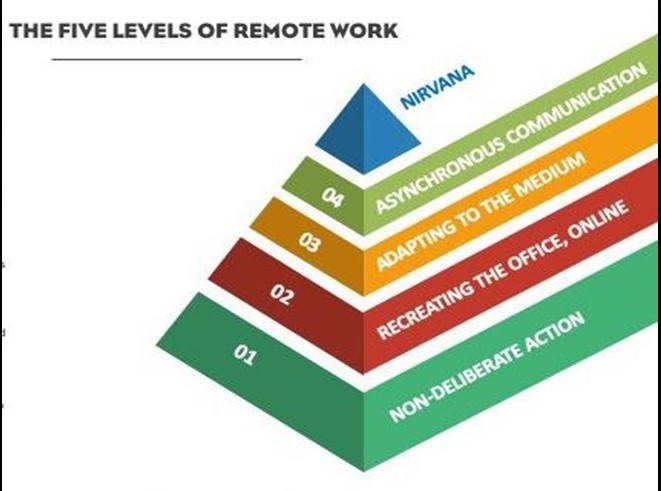Feeling remote
By James Egerton
At the start of 2020, a Springtime of ELT schools moving 100% online was unimaginable. Yet here we are, working out how to optimise online platforms like Zoom and assessing the wider effects on learner needs as we go.
An excellent podcast featuring host Sam Harris and the tech entrepreneur Matt Mullenweg called The New Future of Work helps us with these issues. Mullenweg describes the five levels of remote working from the Factory Model to Nirvana and they then discuss the consequences of remote work for written communication.
I’ll outline how these levels apply to the world of ELT, discuss how the consequences for writing affect our communication with colleagues and how we teach this vital skill.
1. The five levels
Level 0: Factory Model
The Industrial Revolution has set work rules since the mid-1800s, but ‘we’re going to have to re-examine every aspect of our society which makes us over-reliant on physical co-location’ (Mullenweg). There are many positives to face-to-face lessons, but it’s not the only way and we’ve all been experiencing the alternatives during the coronavirus lockdown.
Level 1: Non-deliberate Action
This is getting by when away from the school building, but it’s not nearly as effective as being there physically. Maybe there’s a public transport strike (not uncommon here in Rome!) and you have to email your lesson plan in for the cover teacher, but you can’t actually teach the lesson yourself without being there.
Level 2: Recreating School, Online
Where many schools have been thrust due to (thanks to?) the coronavirus lockdown, and platforms like Zoom are recreating the school online. In other words, we’re now all synchronous - having to be in the same (online) place at the same time and thus recreating the Factory Model with WiFi.
Here, we don’t take full advantage of the possibilities that platforms like Zoom present. Level 2 is also referred to as the ‘Big Brother stage’, where trust is scarce and teachers and school managers seek controls such as proof of screen attention.

Level 3: Adapting
Breakthrough! At Level 3, organisations start to escape the Factory Model and really make the most of the platforms’ possibilities. A few of Mullenweg’s examples can be used in the ELT classroom or meeting room:
- Open a Google Doc and screen share it during a lesson/teacher training session. As one person scribes, all participants are checking if the shared notes reflect their interpretation (scribing is a useful 21st Century writing skill - more effects on writing later on). We did exactly this in a IHWO online CELTA meeting run by my TT coordinator Gianni Licata on 22nd April.
- Transparent communication: Communication is open to everyone in the company through Slack. This 1) makes emails with long CCs redundant and prevents inbox clogging and 2) allows anyone who has a didactic or admin-related idea an open channel to their relevant colleagues.
- Google Alerts: Google Alerts can alert certain people on certain topics. I’m really interested in pronunciation teaching, for example, so I could set my Alerts to inform me when this topic is mentioned. Also, any colleague can alert me by adding my @name.
- Live demoing: Show how apps and functions work on Zoom screen share (for dozens of time-saving apps succinctly summarised, see Hey Sal’s free eBook) http://heysal.net/timesavers/
This optimisation could be coupled with investment in equipment such as audio equipment (from money saved on clothes from the waist down?). It also entails more trust between employer/employee and teacher/learner.
Other challenges appear here, too. Gauging morale and motivation is harder online, but Mullenweg does this through building social chit-chat into meeting time. Here at IH Rome Accademia Britannica, we’ve kept in touch with informal Zoom lesson idea swaps and pub quizzes.
Level 4: Asynchronous Communication
Employees are now judged on output rather than hours, so ‘no more merely existing on work time’ (Harris), and mutual trust has to be fully activated. Flexible schedules also open up the possibility to tap the world’s talent pool and function as a 24/7 company.
Online teaching requires us to be present at the same time as the learners, but I’ve been experimenting with the Nearpod platform for homework tasks this week thanks to a blog post by Katie Lindley on Sandy Millin’s site (https://sandymillin.wordpress.com/2020/04/20/using-nearpod-for-asynchronous-online-teaching-guest-post/). It allows the teacher to leave full lessons and tasks online and learners to complete them whenever they can. Teachers then log back in when convenient to give feedback.
Level 5: Nirvana
‘It’s always good to have an unattainable level...but this is where we have fun experimenting’ - Mullenweg.
Treadmill desk, anyone?
2. Consequences for writing
Task: ‘Write a letter to your cousin Jemima in Canada. 300-word limit, or you’ll have to buy an extra stamp to send it.’
I prefer to sacrifice nostalgia for real-life application in teaching. Moving through the levels above and increased online communication in general have several significant effects on written communication and these should be reflected in how we teach this skill and communicate online ourselves. Tips from the podcast, adapted to ELT:
Improve competency in written communication.
Already important, but clear written communication skills will be even more vital in a future with more employment online. Shouldn’t this fact be reflected in how much time and importance we give to developing writing skills with Young Learners?
De-formalisation for friendliness = Online body language
Communication with emojis
There are many excellent ELT lesson tips available on integrating emojis, such as Lindsay Clandfield’s for Cambridge English, and I suggest using them now that most learners are writing in emoji-rich environments like WhatsApp. Of course, sprinkling messages to colleagues with some friendly emojis can underline positive intent, too.
Punctuation
‘For the longest time, email had to rise to the standard of what you would have written as a letter. It made no sense’ (Sam Harris). I was recently reminded of this by a Spanish friend, who asked me why I always put full stops at the end of my WhatsApp messages, as she found the formality alienating. Compare the following; how do they make you feel?
A. This is not what I was looking for.
B. this isn’t what I was looking for
Mullenweg says that the first is usually read as a strong complaint, whereas the second offers a much gentler version. Although I believe these modern twists can be added to our teaching, I’m certainly not advocating for the complete abandonment of mainstream punctuation rules, especially in formal communication (family and friends will attest to that - I’m a regular corrector!)
Expand brevity
‘You want the message to be as specific as possible and contain all the context, so someone reading it out of context can respond as easily as possible. (Mullenweg). Compare:
A. yes, I agree that the lesson should start five minutes late, so 15.05
B. yes, that sounds good
The first is much less ambiguous; the second could be misunderstood to refer to another message in the stream. Removing dangling pronouns makes all the difference in cutting confusion, as I’ve seen when WhatsApping CELTA co-trainers recently when we’d usually sit down for a face-to-face meeting.
3. API Assume Positive Intent
Not a writing skill per sé, but a useful doctrine for written communication. Our lizard brains can jump to conclusions that the writer didn’t intend.
This is writing’s version of Pastel’s Law: be liberal in what you accept; be conservative in what you put out. When your blood starts to boil with a colleague or CELTA trainee, making an audio call instead of continuing to punch out words on the keyboard is usually helpful. Working remotely, you also have the chance to de-escalate yourself by taking a walk or whatever works for you.
Conclusion
This period is awful in many ways, but it also provides many opportunities, which I hope excite you as both a member of the lockdown community and an ELT professional. As Ray Dalio wrote in his aptly-named article ‘The Changing World Order’, ‘I believe that the times ahead will be radically different from the times we have experienced so far in our lifetimes.’
Orwell wrote that ‘I am told it is bad form for a writer to quote his own reviews’, so forgive me. But in Issue 43 of this publication, in Autumn 2017 - 3BC (Before Coronavirus), I concluded my ELT 2.0 article with the words: ‘Integrating tech into our learners’ language lives is vital for our teaching to have any real life overlap; burying our heads in the sand really isn’t an option.’
If you didn’t believe it then, or even at the start of 2020, then I hope you see it now: technology needs to be part of our teaching and training skill set in these radically different times and beyond. We’ve been jerked awake and into a collective start in ELT, but we’re still far from where we could be.
|
References Benintende, S. (2020). Time Savers. Work Smart. Not Hard (eBook). Available at: http://heysal.net/timesavers/ (Accessed 3/4/2020) Clandfield, L. (2017). Emoji Lesson Pack: 5 Ways Teachers Can Use Emojis in Class. Available at: https://www.cambridge.org/elt/blog/2017/06/08/5_ways_teachers_use_emoji/ (Accessed 20/4/2020) Dalio, R. (2020). The Changing World Order. Available at: https://www.linkedin.com/pulse/changing-world-order-ray-dalio-1f/ (Accessed 17/3/2020) Glaveski, S. (2020). The Five Levels of Remote Work - and Why You’re Probably at Level 2. Available at: https://medium.com/swlh/the-five-levels-of-remote-work-and-why-youre-probably-at-level-2-ccaf05a25b9c (Accessed 5/4/2020) Harris, S. and Mullenweg, M. (2020). The New Future of Work. Making Sense Podcast. Available at: https://www.youtube.com/watch?v=mJSf2Clx6qY&t=15s (Accessed 27/3/2020) Lindley, K. (2020). Using Nearpod for Asynchronous Online Teaching. Available at: https://sandymillin.wordpress.com/2020/04/20/using-nearpod-for-asynchronous-online-teaching-guest-post/ (Accessed 21/4/2020) Orwell, G. (1937). The Road to Wigan Pier. Viktor Gollancz: London. |
Author's bio: James currently works at International House Riga-Satva in Latvia after 5 years teaching in Spain, and is a keen exponent of applying mindset theory to classrooms and staffrooms. He had an article published in IATEFL Voices on the topic in the November-December 2016 edition, and the concept appears regularly on his blog at www.jamesegerton.wordpress.com.
